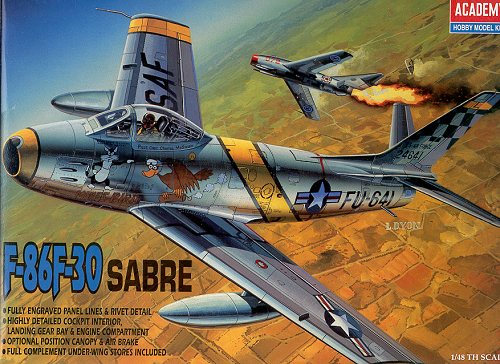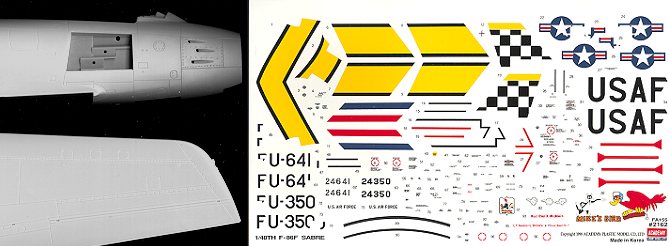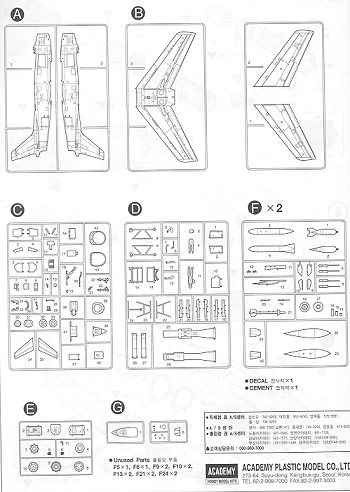
| KIT: | Academy 1/48 F-86F-30 Sabre |
| KIT # | 2162 |
| PRICE: | $25.00 |
| DECALS: | See review |
| REVIEW & | |
| NOTES: | Has full engine detail |

| HISTORY |
Think of the F-86 Sabre and most people think of the Korean War.It was the Sabre that managed to keep air superiority over the surprising MiG-15that suddenly appeared in the skies in late 1950. Built in very large numbersfor the time, the Sabre was eventually exported to over 25 different countries,some of which only retired their F-86s in the late 1980s, over fourty yearssince the aircraft first flew. Today, several are being used by sportsmen and astarget tugs.
The F-86F-30 was brought into the conflict late and had severalimprovements over earlier Sabres. One thing that was needed was greatermaneuverability. This was accomplished by deleting the leading edge slats andincreasing the area of the leading edge of the wing. This was called the 6-3wing modification as it was 3 inches wider at the tip and 6 inches wider at thewing root. Eventually, most F-86s, including older models, received thismodification, and it was standard on later versions.
| THE KIT |
 Academy's kit is inlight grey plastic with superb engraved detailing. It comes with two pilotfigures, one standing and one sitting, a full engine, openable gun bayswith guns, positionable speedbrakes, two styles of drop tanks, and an innerpylon with bombs. Also included are Sidewinder missiles and rails. Though theseare not applicable to the Korean War versions, they would be if doing aLuftwaffe or Taiwanese Sabre. Should you decide to display the kit with theengine showing, you need to cut the fuselage. There is also a trolley forholding the rear fuselage half.
Academy's kit is inlight grey plastic with superb engraved detailing. It comes with two pilotfigures, one standing and one sitting, a full engine, openable gun bayswith guns, positionable speedbrakes, two styles of drop tanks, and an innerpylon with bombs. Also included are Sidewinder missiles and rails. Though theseare not applicable to the Korean War versions, they would be if doing aLuftwaffe or Taiwanese Sabre. Should you decide to display the kit with theengine showing, you need to cut the fuselage. There is also a trolley forholding the rear fuselage half.
 The instructionsinclude the usual history, warnings, parts guide, painting guide, and a 15 stepconstruction sequence. No strict FS callout is offered in the painting guide,only general paint names, i.e. dark grey, are given. The painting an decalplacement guide is a separate sheet and quite comprehensive, as is the decalsheet. One gets two options; a fighter, 'Mike's Bird' of the 51FW and afighter-bomber of the 18 FBW. There are full stencils and theater markingsincluded. The decals that go on the speedbrakes are precut to ensure a properfit. One small note, the instrument panel for the fighter andfighter-bomber versions are different, the latter having an extra bomb panel.The kit supplies the fighter-bomber panel which is inaccurate for the fighterversion.
The instructionsinclude the usual history, warnings, parts guide, painting guide, and a 15 stepconstruction sequence. No strict FS callout is offered in the painting guide,only general paint names, i.e. dark grey, are given. The painting an decalplacement guide is a separate sheet and quite comprehensive, as is the decalsheet. One gets two options; a fighter, 'Mike's Bird' of the 51FW and afighter-bomber of the 18 FBW. There are full stencils and theater markingsincluded. The decals that go on the speedbrakes are precut to ensure a properfit. One small note, the instrument panel for the fighter andfighter-bomber versions are different, the latter having an extra bomb panel.The kit supplies the fighter-bomber panel which is inaccurate for the fighterversion.
As a note, often times the fighter-bombers were referred to as-50 series aircraft, vice -30 series. This makes the 18FBW aircraft an F-86F-52and not an F-86F-30. Externally, except for the bomb racks, they are the same.Internally, the instrument panel is the biggest difference.
There has been some speculation that the Academy kit is just aknock-off or copy of the Hasegawa kit. With that in mind, I purchased a HasegawaF-86F-30 kit, this one in Skyblazers markings. There are a great manysimilarities, and also a number of differences. The panel sizes on the wings andfuselage halves are not exactly the same. Same goes for wheel well andspeedbrake well detailing. The Hasegawa kit has a separate cockpit while theAcademy kit molds it on the top of the upper intake trunk. The Hasegawa fuselageis for a Japanese F-86F-40 and so has some intakes and exhaust ports that areinappropriate for the F-86F-30 and not on the Academy fuselage.
My conclusion is that Academy didn't copy the Hasegawa kit. Liketwo or three companies doing the same Bf-109G-6, there are bound to be closesimilarities, especially if all involved are trying to be as exact as possible.As for which one builds better, I cannot tell, but test fitting a few partsshows the fit to be excellent.
Review copy courtesy of me and my wallet!! If any of youmanufacturers or shop owners want to send products for review and building,please contact me.